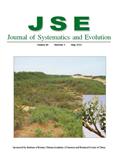Yu-Peng GUO, Ru ZHANG, Cui-Yun CHEN, Dang-Wei ZHOU, Jian-Quan LIU
In this study, we aimed to study the phylogeographical pattern of Juniperus sabina, a shrub species commonly occurring in the northern, northwestern and western China. We sequenced three chloroplast DNA fragments (trnL-trnF, trnS-trnG and trnD-trnT) for 137 individuals from 16 populations of this species. Five chloroplast DNA (cpDNA) chlorotypes (A, B, C, D and E) were identified and they showed no overlapping distribution. The population subdivision is very high (GST = 0.926, NST = 0.980), suggesting distinct phylogeographical structure (NST > GST, P < 0.05). Phylogenetic analyses of the five chlorotypes clustered into three clades which were consistent with their respective distributions in three separate regions: northern Xinjiang, western Xinjiang and northern-northwestern China. However, within each region, the inter-population differentiation is extremely low. These results as well as statistical tests suggested distinct allopatric differentiations between regional populations and independent glacial refugia for postglacial recolonization. The deserts developed during the late Quaternary might have acted as the effective barriers to promote genetic differentiation among these regions. However, the low diversity dominated by the single chlorotype within each fragmented region suggested that all current populations were derived from a common regional range expansion respectively.

